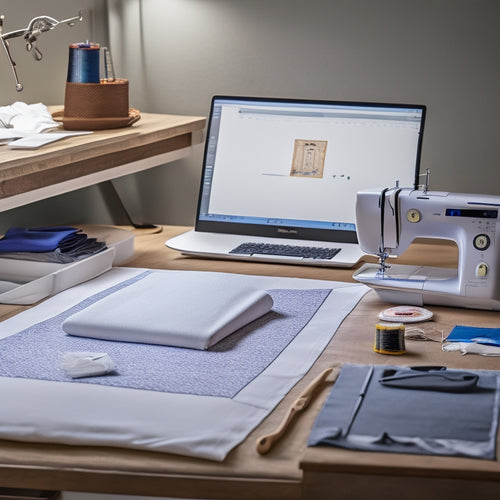
How High off the Ground Is a Ballet Bar?
Share
When setting up a ballet bar, you should position it about 1-2 inches below your hipbone, guaranteeing a comfortable and relaxed arm position that avoids unnecessary strain on your muscles and maintains proper technique. Consider your own height and dancing style when determining the ideal bar height. For a more customized fit, measure the distance from your wrist crease to the floor. You'll want to make sure the bar is at a height that allows for proper body proportions and comfortable movement. Now that you've got the basics covered, discover how to further optimize your ballet bar setup for top performance.
Key Takeaways
• The ideal ballet bar height is about 1-2 inches below the hipbone, allowing for a relaxed arm position and proper technique.
• Measure the wrist crease to the floor to determine the ideal bar height, ensuring proper barrel alignment and comfortable floor clearance.
• Adjustable bars are beneficial for accommodating different heights, ages, and abilities, and are ideal for shared spaces or multi-user environments.
• Bar height ranges vary by age group: 24-30 inches for children, 30-36 inches for pre-teens, 36-42 inches for teenagers, and 42-48 inches for adults.
• Proper bar height is crucial to prevent unnecessary strain on muscles and affect technique, promoting comfortable movement and injury prevention.
Determining Ideal Bar Height
When determining the ideal height of your ballet bar, consider your own height and dancing style, as a bar that's too high or too low can put unnecessary strain on your muscles and affect your technique.
As a general rule, the bar should be set at a height that allows you to stand comfortably with your arm relaxed by your side, with your elbow slightly bent.
For barre selection, look for adjustable bars that can accommodate different heights and styles. Bar height standards vary, but a good starting point is to position the bar at a height that's about 1-2 inches below your hipbone.
This will allow you to maintain proper posture and alignment, ensuring you can move freely and focus on perfecting your technique.
Age and Height Considerations
As you adjust the bar to suit your needs, consider that children and teenagers typically require lower bar heights than adults, while taller dancers may need higher settings to maintain proper alignment. This is important for youth development, as proper body proportions are essential for best technique and injury prevention.
Here are some key considerations to keep in mind:
-
Children (ages 5-8): Bar height should be around 24-30 inches to accommodate smaller body proportions.
-
Pre-teens (ages 9-12): Bar height should be around 30-36 inches, allowing for gradual growth and development.
-
Teenagers (ages 13-18): Bar height should be around 36-42 inches, catering to their increasing height and body proportions.
- Adults: Bar height should be around 42-48 inches, providing excellent support and alignment for taller dancers.
Measuring for Proper Fit
You'll want to measure the distance from the floor to the inside of your wrist crease to determine the ideal bar height that suits your body proportions. This guarantees proper barrel alignment and allows for comfortable floor clearance. To get an accurate measurement, stand up straight with your arms relaxed by your sides.
| Height Range | Wrist Crease to Floor | Ideal Bar Height |
|---|---|---|
| 5'2'-5'5' | 24-26 inches | 38-40 inches |
| 5'6'-5'9' | 26-28 inches | 40-42 inches |
| 5'10'-6'1' | 28-30 inches | 42-44 inches |
| 6'2' and up | 30-32 inches | 44-46 inches |
Adjustable Barre Options
Adjustable barre options offer flexibility in accommodating different users or providing varied exercise experiences, allowing you to customize the bar height to suit your specific needs. This feature is particularly useful for shared spaces or multi-user environments.
Here are some benefits of adjustable barre options:
-
Portability benefits:
Easy to relocate or store when not in use. -
Space savers:
Ideal for small studios or homes with limited space. -
Customization:
Accommodate users of different heights or abilities.
-
Versatility:
Provide varied exercise experiences or adapt to different dance styles.
Studio Setup and Placement
Position your ballet barre in a way that creates a safe and functional studio setup, considering factors like floor space, traffic flow, and accessibility.
When floor planning, think about the flow of your studio and how dancers will move around the space.
Consider the ballet barre's placement in relation to mirrors, doors, and other obstacles.
Make the most of corner utilization by placing the barre in a way that creates a comfortable and efficient workspace.
Don't forget to leave enough space between the barre and the wall for dancers to move freely.
Frequently Asked Questions
Can Ballet Bars Be Used for Other Forms of Exercise or Dance?
You can repurpose ballet bars for other exercises, like Pilates modifications or yoga adaptations, allowing you to modify moves, increase flexibility, and enhance overall fitness while experiencing the freedom to explore new movements.
How Often Should Ballet Bars Be Cleaned and Disinfected?
You'll be shocked to know that 80% of illnesses are caused by dirty surfaces! To avoid germs spreading, you should practice daily sanitizing of ballet bars, especially after intense use, to guarantee a healthy and free-spirited workout environment.
Are There Any Safety Precautions When Using a Ballet Bar?
When utilizing a ballet bar, you should guarantee a proper grip to avoid injuries, and stand on soft flooring to reduce impact; also, warm up before exercising and cool down afterwards to prevent strains.
Can Ballet Bars Be Mounted on a Permanent Wall or Floor?
You can securely install ballet bars on permanent walls or floors using floor anchors or by locating wall studs, choosing from various mount types and installation methods that guarantee stability and freedom of movement.
Are Ballet Bars Suitable for Outdoor or Temporary Setups?
You're not limited to traditional studios - a million possibilities await! Ballet bars are perfect for portable studios and event rentals, offering flexible, temporary setups that can be easily assembled and disassembled as needed.
Related Posts
-

7 Essential Training Secrets for Dance Makeup Artists
You're about to discover the secrets to transforming your dance makeup artistry into a thriving online business, wher...
-

Revamp PDF Sewing Patterns With Copy Shop Ease
You can revamp your PDF sewing patterns to achieve copy shop ease by streamlining the conversion process and optimizi...
-

Captivating Ballerina SVG Designs for DIY Enthusiasts
Ballerina SVG designs have captured the interest of DIY enthusiasts and crafters, providing a versatile and sophistic...


